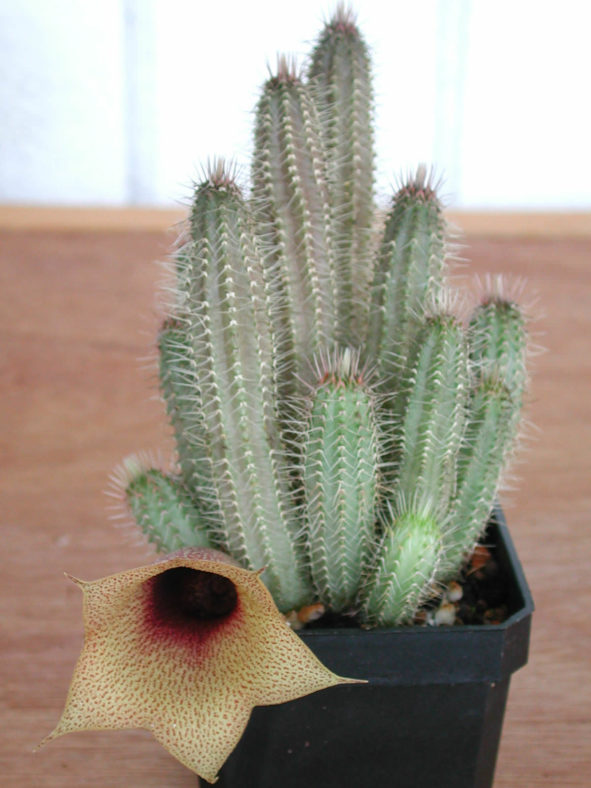Scientific Name
Tavaresia barklyi (Dyer) N.E.Br.
Common Name(s)
Thimble Flower, Devil's Trumpet
Synonym(s)
Decabelone barklyi, Decabelone grandiflora, Euphorbia antunesii
Scientific Classification
Family: Apocynaceae
Subfamily: Asclepiadoideae
Tribe: Ceropegieae
Subtribe: Stapeliinae
Genus: Tavaresia
Etymology
The specific epithet "barklyi" (pronounced "BARK-lee") honors Sir Henry Barkly (1815-1898), a British politician, colonial governor, and patron of the sciences, who collected specimens of this species in 1871.
Origin
Tavaresia barklyi is native to South Africa, Angola, Botswana, Namibia, and Zimbabwe.
Description
Tavaresia barklyi is a succulent plant with erect blue-green stems covered with tubercles tipped with three sharp bristles. The stems are cylindrical with 10 to 12 ribs and can grow up to 2.4 inches (6 cm) tall and 0.6 inches (1.5 cm) in diameter.
During the summer, Tavaresia barklyi produces showy, tubular to trumpet-shaped flowers that can reach a length of 4.4 inches (11 cm) and a diameter of 1 inch (2.5 cm). The flowers arise at the base of the stems. They can be pale yellow, yellowish-pink, or cream-colored, with dark red spots and streaks on the outside, darker on the inside, and almost entirely maroon to purple at the base inside. The fruits consist of a pair of elongated follicles that, when fully mature, burst open to release seeds, each with a tuft of hair.

How to Grow and Care for Tavaresia barklyi
Hardiness: USDA hardiness zones 11a to 11b: from 40°F (4.4°C) to 50°F (10°C).
Tavaresias are primarily grown by plant collectors, succulent enthusiasts, and individuals who appreciate growing unusual-looking plants. They originate from areas with summer rainfall and are intolerant of excess water, humidity, and low winter temperatures, as well as being susceptible to mold damage. Flower buds drop off easily in response to the slightest touch or unfavorable conditions. Tavaresias prefer light shade rather than full sun, although stems may not color up under shady conditions. These succulents thrive in well-draining, gritty soil with ample light.
Plants are usually increased by cuttings, which, as they are very succulent, should be allowed to dry for a week after they are taken off, when they may once be put singly into pots. Grafting the Tavaresia on Stapelias is often useful and can be recommended.
Learn more at How to Grow and Care for Tavaresia.
Links
- Back to genus Tavaresia
- Succupedia: Browse succulents by Scientific Name, Common Name, Genus, Family, USDA Hardiness Zone, Origin, or cacti by Genus
Photo Gallery
Click on a photo to see a larger version.


